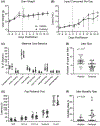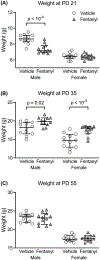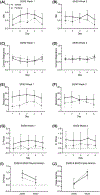Enduring consequences of perinatal fentanyl exposure in mice
- PMID: 32187805
- PMCID: PMC7897444
- DOI: 10.1111/adb.12895
Enduring consequences of perinatal fentanyl exposure in mice
Abstract
Opioid use by pregnant women is an understudied consequence associated with the opioid epidemic, resulting in a rise in the incidence of neonatal opioid withdrawal syndrome (NOWS) and lifelong neurobehavioral deficits that result from perinatal opioid exposure. There are few preclinical models that accurately recapitulate human perinatal drug exposure and few focus on fentanyl, a potent synthetic opioid that is a leading driver of the opioid epidemic. To investigate the consequences of perinatal opioid exposure, we administered fentanyl to mouse dams in their drinking water throughout gestation and until litters were weaned at postnatal day (PD) 21. Fentanyl-exposed dams delivered smaller litters and had higher litter mortality rates compared with controls. Metrics of maternal care behavior were not affected by the treatment, nor were there differences in dams' weight or liquid consumption throughout gestation and 21 days postpartum. Twenty-four hours after weaning and drug cessation, perinatal fentanyl-exposed mice exhibited signs of spontaneous somatic withdrawal behavior and sex-specific weight fluctuations that normalized in adulthood. At adolescence (PD 35), they displayed elevated anxiety-like behaviors and decreased grooming, assayed in the elevated plus maze and sucrose splash tests. Finally, by adulthood (PD 55), they displayed impaired performance in a two-tone auditory discrimination task. Collectively, our findings suggest that perinatal fentanyl-exposed mice exhibit somatic withdrawal behavior and change into early adulthood reminiscent of humans born with NOWS.
Keywords: C57BL/6; development; neonatal abstinence syndrome; opiates; postnatal; prenatal.
© 2020 Society for the Study of Addiction.
Figures





References
-
- Spencer MR, Warner M, Bastian BA, Trinidad JP, Hedegaard H. Drug overdose deaths involving fentanyl, 2011–2016. Natl Vital Stat Rep Cent Dis Control Prev Natl Cent Health Stat Natl Vital Stat Syst. 2019;68(3):1–19. - PubMed
Publication types
MeSH terms
Substances
Grants and funding
LinkOut - more resources
Full Text Sources

